Search Results
Fine Jewelry University Articles matching: “14k gold 160 g”
Showing only FJU Article results. Click here to show all results.
Fine Jewelry University (Show All FJU Articles)
-
Synthetic Gems: The Whole Story
Ruby, sapphire, emerald and alexandrite are very beautiful gems and very rare in their stunning beauty. These four gems have been coveted by rulers and the rich for thousands of… if anyone could own them? At gem shows and museums, I have seen jaw dropping rubies, sapphires and emeralds. These gems in high quality have put ownership beyond most people to justify the price. Just a one carat gem could cost $3,000… ring where people can spend over $10,000 routinely. The answer was to find a less expensive way to have these gems. It took over a hundred years and millions of dollars of research to create what nature can produce. Man made gems come…
-
Understanding the Diamond Buying Game
…. The soda is the same and you can shop based on price or convenience; the product is the same. People like shopping this way. I like it this way. Diamonds are not this way. The four C’s of diamonds are not that old, less than 100 … that system every business and diamond seller had their own system. It was impossible to buy a diamond without seeing it first. The GIA four C system is supposed to be an agreed upon grading standard but in reality this is not always …
-
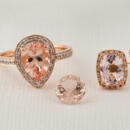
Gem in the Spotlight: Morganite
Morganite is a beautiful, soft pink gemstone and a graceful expression of elegance. It is not a very well-known gem, but …pink hue though it also occurs as soft pink, violet-pink, or pale salmon. It is the subtle, understated nature of Morganite’s color that sets it apart from many of the more popular gemstones. Morganite has an impressive family tree. It… aquamarine. Because of its association with emerald it is sometimes called “Pink Emerald”. Other names for Morganite are “Pink Beryl”, “Rose Beryl”, and “Cesian (or caesian ) Beryl”. “Cesian” refers to the presence of the mineral …
-
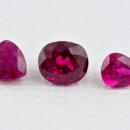
Gem in the Spotlight: Ruby
For much of human history, rubies have been the most prized gemstone. But, what is it about this red gem that has captivated our hearts and minds for so long? Is it ruby’s color… its high cost? Or, is it something deeper? Whatever it is, ruby’s impact on humanity is broad and deep, with arguably the richest history of all gemstones. Gemology of Ruby Rubies are in the corundum gem family along with sapphires. … is an extremely durable form of aluminum oxide with a Moh’s hardness of 9. This makes ruby one of the hardest gems commonly used in jewelry second only to diamond (which has a Moh’s hardness of 10) and moissanite (which is in between…
-
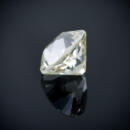
The History of Diamond Cuts
One of the earliest recorded statements about diamonds is: “the substance that possesses the greatest value, not only among the precious stones, but of all human possessions.” said by Pliny, the Roman historian… is the story of humankind’s love of diamonds and our quest to unlock their true brilliance. Before Diamond Cutting The Romans loved diamonds but did not have the technology to change their shape. So, the Romans wore uncut diamonds. …without any human modification. Diamonds normally form in the octahedral shape which looks like two pyramids stuck together at the base. Naturally, the first attempts to enhance diamonds were to polish the natural gem. The “point cut” …
-
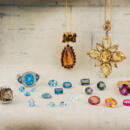
Gem in the Spotlight: Topaz
… one person say, “I love Topaz; it reminds me of a blue sky.” Then her friend says back, “Topaz may be like a golden sunset, but not the sky.” A third friend will chime in, “You’re both crazy, it’s like a beautiful peach.” Then, a …names: Imperial Topaz: When both orange and red colors are present (although much of the jewelry industry might call golden topaz imperial). Golden Topaz: Yellow to orange without any red component (could be called precious topaz if more …
-
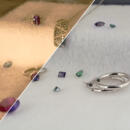
Gem in the Spotlight: Alexandrite
Emerald by day, ruby by night, more expensive than diamond and more illustrious than sapphire, emerald, or even ruby, alexandrite has been known… world as one of the most sought-after gems for the better part of 200 years. But, what makes this stone so special? Gemology of Alexandrite Alexandrite is the extremely rare, color-change variety of a gem species called Chrysoberyl. …appears bluish-green in daylight, fluorescent light, and some LED light. Under incandescent light, candle, and firelight, alexandrite appears purplish-red. This is because of how the trace element chromium interacts with alexandrite’s …
-
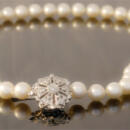
How to Clean Pearl Jewelry
Pearls are considered by many to be symbols of purity and chastity. But even symbols of purity get dirty from time to time. As you know pearls are produced when a mollusk secretes nacre to form a covering around a… by the heaving pressure beneath the earth’s surface. Therefore special attention should be used when cleaning them. Pearls should be the last thing that you put on and the first thing that you take off. Common personal products like … and perfume can severely damage pearls. They should be cleaned in warm soapy water periodically, gently scrubbing individually with a soft brush. A soft brush must be used so as not to scratch the surface of the pearl. Care must be …
-
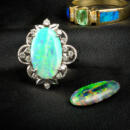
Gem in the Spotlight: Opal
Opal has been described as containing the wonders of the skies, sparkling rainbows, fireworks, and lightning. Its dazzling play of color is totally unique… that surrounds it is almost as colorful as the gem itself. Opal is the traditional birthstone for those lucky enough to born in October, and it is found in a huge variety of colors (sometimes all within the same stone). Gemology of … dance of colors is a result of its unique internal structure. This gemstone is composed of tiny silica spheres arranged in a pattern, which diffract light and create the spectacular play of colors known as opalescence . The colors …